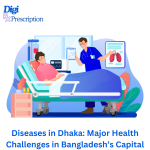
Dhaka, the capital of Bangladesh, is one of the most densely populated cities in the world. Due to rapid urbanization, pollution, and poor sanitation, the city faces significant public health challenges. Infectious diseases, non-communicable diseases, and environmental health risks are widespread, affecting millions of residents every year. In this blog, we will explore the most common diseases in Dhaka, their causes, symptoms, and prevention strategies.
1. Dengue Fever: A Seasonal Epidemic
Dengue fever is one of the deadliest mosquito-borne diseases in Dhaka, with frequent outbreaks, especially during the monsoon season.
Cause: Transmitted by Aedes mosquitoes.
Symptoms: High fever, severe joint pain, vomiting, skin rash, and internal bleeding in severe cases.
2023 Outbreak: Over 321,000 cases and 1,705 deaths recorded.
2024 Situation: Over 78,000 cases and 400+ deaths reported so far.
Prevention: Mosquito control, using repellents, and eliminating stagnant water.
???? Source: Reuters
2. Air Pollution-Related Respiratory Diseases
Dhaka has one of the worst air quality levels in the world, leading to severe respiratory issues.
Common Diseases: Asthma, chronic obstructive pulmonary disease (COPD), lung infections, and bronchitis.
Annual Death Toll: Over 235,000 deaths in Bangladesh linked to air pollution.
Impact on Children: More than 19,000 child deaths annually due to respiratory infections.
Prevention: Reduce vehicle emissions, wear masks, and improve indoor air ventilation.
???? Source: UNICEF Bangladesh
3. Waterborne Diseases: Cholera, Diarrhea, and Typhoid
Poor sanitation and water contamination in Dhaka lead to frequent outbreaks of waterborne diseases.
Cholera & Diarrhea: Common in slums and flood-affected areas.
Typhoid: Spread through contaminated food and water.
Symptoms: Severe diarrhea, dehydration, fever, vomiting, and stomach pain.
Prevention: Drink safe water, improve sanitation, and get vaccinated.
???? Source: ICDDR,B
4. Tuberculosis (TB)
Dhaka has one of the highest tuberculosis infection rates in Bangladesh.
Cause: Mycobacterium tuberculosis, spread through airborne droplets.
Symptoms: Persistent cough, chest pain, weight loss, fever, and night sweats.
Annual Cases: Over 220,000 new infections reported in Bangladesh.
Mortality Rate: 24 per 100,000 people.
Prevention: BCG vaccination, early diagnosis, and complete medication courses.
???? Source: WHO Global TB Report
5. COVID-19 and Seasonal Influenza
Although COVID-19 cases have reduced, seasonal flu and respiratory infections remain major concerns in Dhaka.
Symptoms: Fever, cough, difficulty breathing, fatigue, and sore throat.
Prevention: Regular handwashing, wearing masks in crowded places, and vaccination.
???? Source: WHO COVID-19 Bangladesh Updates
6. Malnutrition and Stunting in Children
Malnutrition is a significant issue in Dhaka, particularly among low-income communities.
Stunting Rate: 28% of children under five are stunted.
Wasting Rate: 10% of children suffer from acute malnutrition.
Causes: Food insecurity, poor maternal nutrition, and lack of breastfeeding.
Prevention: Promote breastfeeding, provide nutritious food, and educate parents.
???? Source: UNICEF Bangladesh
7. Mental Health Disorders
The fast-paced lifestyle, urban stress, and economic hardships in Dhaka have led to a rise in mental health issues.
Common Disorders: Depression, anxiety, stress-related disorders, and PTSD.
Prevalence: Over 4.6 million Bangladeshis suffer from depression.
Challenges: Lack of mental health professionals and social stigma.
Prevention: Mental health awareness, counseling services, and stress management programs.
???? Source: [National Institute of Mental Health (NIMH), Bangladesh]
8. Chronic Kidney Disease (CKD)
Chronic kidney disease is increasing due to diabetes, hypertension, and pollution in Dhaka.
Prevalence: About 20 million people affected.
Major Causes: Uncontrolled diabetes, high salt intake, and contaminated water.
Prevention: Monitor blood sugar and blood pressure, reduce salt intake, and stay hydrated.
???? Source: [Bangladesh Renal Association]
9. Hepatitis B & C
Hepatitis is a serious health issue in Dhaka due to lack of awareness and unsafe medical practices.
Hepatitis B Prevalence: 3-5% of the population is infected.
Hepatitis C Cases: Increasing due to unsafe injections and blood transfusions.
Symptoms: Jaundice, liver failure, and fatigue.
Prevention: Hepatitis B vaccination, safe medical practices, and regular screening.
???? Source: [Bangladesh Liver Foundation]
10. Nipah Virus: An Emerging Threat
The Nipah virus is a highly fatal disease that has seen outbreaks in Bangladesh, including Dhaka.
Cause: Nipah virus, transmitted from bats or contaminated food.
Symptoms: Fever, vomiting, brain inflammation (encephalitis), and coma.
Fatality Rate: 40-75%, making it one of the deadliest viruses.
Prevention: Avoid consuming raw date palm sap, maintain hygiene, and improve disease surveillance.
???? Source: CDC Bangladesh
Conclusion
Dhaka's rapid urbanization, pollution, and poor healthcare access contribute to the high prevalence of infectious and chronic diseases. Government interventions, improved sanitation, better waste management, and public awareness campaigns are essential to controlling the disease burden. Strengthening the healthcare system and ensuring preventive measures can help create a healthier future for Dhaka's residents.
References:
WHO Bangladesh Health Data – WHO
UNICEF Bangladesh – UNICEF
Reuters Dengue Report – Reuters
ICDDR,B Waterborne Disease Reports – ICDDR,B
CDC Nipah Virus Information – CDC
Bangladesh Liver Foundation – Hepatitis Data
National Institute of Mental Health (NIMH), Bangladesh
